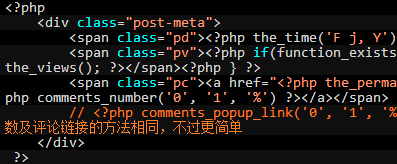wordpress是一种使用PHP语言开发的博客平台,用户可以在支持PHP和MySQL 数据库的服务器上架设自己的网志,插件众多,易于扩充功能。安装和使用都非常方便。目前 WordPress 已经成为主流的 Blog 搭建平台。本站就用的是WordPress构建的。
WordPress主体包含的主要文件
- WordPress模板基本文件
- style.css 样式表文件
- index.php 主页文件
- single.php 日志单页文件
- page.php 页面文件
- archvie.php 分类和日期存档页文件
- searchform.php 搜索表单文件
- search.php 搜索页面文件
- comments.php 留言区域文件(包括留言列表和留言框)
- 404.php 404错误页面
- header.php 网页头部文件
- sidebar.php 网页侧边栏文件
- footer.php 网页底部文件
- WordPress Header头部 PHP代码
注: 也就是位于和之间的PHP代码
网站标题
[php]<?php wp_title(); ?>[/php]
日志或页面标题
[php]<?php bloginfo(‘stylesheet_url’); ?>[/php]
WordPress主题样式表文件style.css的相对地址
WordPress博客的Pingback地址
WordPress主题文件的相对地址
博客的Wordpress版本
WordPress博客的Atom地址
WordPress博客的RSS2地址
WordPress博客的绝对地址
WordPress博客的名称
网站的HTML版本
网站的字符编码格式
WordPress 主体模板 PHP代码
日志内容
确认是否有日志
如果有,则显示全部日志
结束PHP函数”while”
结束PHP函数”if”
header.php文件的内容
sidebar.php文件的内容
footer.php文件的内容
显示格式为”02-19-08″的日期
显示一篇日志的留言链接
显示一篇日志或页面的标题
显示一篇日志或页面的永久链接/URL地址
显示一篇日志或页面的所属分类
显示一篇日志或页面的作者
显示一篇日志或页面的ID
显示一篇日志或页面的编辑链接
显示Blogroll中的链接
comments.php文件的内容
显示一份博客的页面列表
显示一份博客的分类列表
下一篇日志的URL地址
上一篇日志的URL地址
调用日历
显示一份博客的日期存档列表
显示较新日志链接(上一页)和较旧日志链接(下一页)
显示博客的描述信息
其它的一些Wordpress模板代码
/%postname%/ 显示博客的自定义永久链接
搜索表单的值
打印输出信息
显示注册链接
显示登入/登出链接
<!–next page–> 在日志或页面中插入分页
<!–more–> 截断日志
显示管理员的相关控制信息
显示载入页面的时间
显示载入页面查询
1. wordpress调用最新文章
WordPress最新文章的调用可以使用一行很简单的模板标签wp_get_archvies来实现. 代码如下:
(显示10篇最新更新文章)
或者
后面这个代码显示你博客中最新的20篇文章,其中format=custom这里主要用来自定义这份文章列表的显示样式。具体的参数和使用方法你可 以参考官方的使用说明- wp_get_archvies。(fromat=custom也可以不要,默认以UL列表显示文章标题。)
补充: 通过WP的query_posts()函数也能调用最新文章列表, 虽然代码会比较多一点,但可以更好的控制Loop的显示,比如你可以设置是否显示摘要。具体的使用方法也可以查看官方的说明。
2. wordpress调用随机文章
$rand_posts = get_posts(‘numberposts=10&orderby=rand’);
foreach( $rand_posts as $post ) :
?>
<!–下面是你想自定义的Loop–>
”>
3. wordpress调用最新留言
下面是我之前在一个Wordpress主题中代到的最新留言代码,具体也记不得是哪个主题了。该代码直接调用数据库显示一份最新留言。其中 LIMIT 10限制留言显示数量。绿色部份则是每条留言的输出样式。
global $wpdb;
$sql = “SELECT DISTINCT ID, post_title, post_password, comment_ID,
comment_post_ID, comment_author, comment_date_gmt, comment_approved,
comment_type,comment_author_url,
SUBSTRING(comment_content,1,30) AS com_excerpt
FROM $wpdb->comments
LEFT OUTER JOIN $wpdb->posts ON ($wpdb->comments.comment_post_ID =
$wpdb->posts.ID)
WHERE comment_approved = ’1′ AND comment_type = ” AND
post_password = ”
ORDER BY comment_date_gmt DESC
LIMIT 10″;
$comments = $wpdb->get_results($sql);
$output = $pre_HTML; foreach ($comments as $comment) {
$output .= “n
”.strip_tags($comment->comment_author)
.”:” . ” ID) .
“#comment-” . $comment->comment_ID . “” title=”on ” .
$comment->post_title . “”>” . strip_tags($comment->com_excerpt)
.”
”;
} $output .= $post_HTML;
echo $output;?>
4.wordpress调用相关文章
在文章页显示相关文章
$tags = wp_get_post_tags($post->ID);
if ($tags) {
$first_tag = $tags[0]->term_id;
$args=array(
‘tag__in’ => array($first_tag),
‘post__not_in’ => array($post->ID),
‘showposts’=>10,
‘caller_get_posts’=>1
);
$my_query = new WP_Query($args);
if( $my_query->have_posts() ) {
while ($my_query->have_posts()) : $my_query->the_post(); ?>
” rel=”bookmark” title=””>
endwhile;
}
}
wp_reset_query();
?>
5.wordpress调用指定分类的文章
” rel=”bookmark” title=””>
6.wordpress去评论者链接的评论输出
global $wpdb;
$sql = “SELECT DISTINCT ID, post_title, post_password, comment_ID,
comment_post_ID, comment_author, comment_date_gmt, comment_approved,
comment_type,comment_author_url,
SUBSTRING(comment_content,1,14) AS com_excerpt
FROM $wpdb->comments
LEFT OUTER JOIN $wpdb->posts ON ($wpdb->comments.comment_post_ID =
$wpdb->posts.ID)
WHERE comment_approved = ’1′ AND comment_type = ” AND
post_password = ”
ORDER BY comment_date_gmt DESC
LIMIT 10″;
$comments = $wpdb->get_results($sql);
$output = $pre_HTML;
foreach ($comments as $comment) {
$output .= “
”.strip_tags($comment->comment_author).”:” . ” ID) .
“#comment-” . $comment->comment_ID . “” title=”on ” .
$comment->post_title . “”>” . strip_tags($comment->com_excerpt).”
”;
}
$output .= $post_HTML;
echo $output;?>
7.wordpress调用含gravatar头像的评论输出
global $wpdb;
$sql = “SELECT DISTINCT ID, post_title, post_password, comment_ID, comment_post_ID, comment_author, comment_date_gmt, comment_approved,comment_author_email, comment_type,comment_author_url, SUBSTRING(comment_content,1,10) AS com_excerpt FROM $wpdb->comments LEFT OUTER JOIN $wpdb->posts ON ($wpdb->comments.comment_post_ID = $wpdb->posts.ID) WHERE comment_approved = ’1′ AND comment_type = ” AND comment_author != ‘郑 永’ AND post_password = ” ORDER BY comment_date_gmt DESC LIMIT 10″;
$comments = $wpdb->get_results($sql);
$output = $pre_HTML;
foreach ($comments as $comment)
{
$output .= “
”.get_avatar(get_comment_author_email(‘comment_author_email’), 18). ” ID) . “#comment-” . $comment->comment_ID . “” title=”” . $comment->post_title . ” 上的评论”>”. strip_tags($comment->comment_author) .”: “. strip_tags($comment->com_excerpt) .”
”;
}
$output .= $post_HTML;
$output = convert_smilies($output);
echo $output;
?>
上面代码把comment_author的值改成你的ID,18是头像大小,10是评论数量。
8.wordpress调用网站统计大全
1、日志总数:
publish;?>
2、草稿数目:
3、评论总数:
4、成立时间:
5、标签总数:
6、页面总数:
7、分类总数:
8、链接总数:
9、用户总数:
10、最后更新:
get_results(“SELECT MAX(post_modified) AS MAX_m FROM $wpdb->posts WHERE (post_type = ‘post’ OR post_type = ‘page’) AND (post_status = ‘publish’ OR post_status = ‘private’)”);$last = date(‘Y-n-j’, strtotime($last[0]->MAX_m));echo $last; ?>
9.wordpress判断语句
is_single()
判断是否是具体文章的页面
is_single(’2′)
判断是否是具体文章(id=2)的页面
is_single(‘Beef Stew’)
判断是否是具体文章(标题判断)的页面
is_single(‘beef-stew’)
判断是否是具体文章(slug判断)的页面
comments_open()
是否留言开启
pings_open()
是否开启ping
is_page()
是否是页面
is_page(’42′)
id判断,即是否是id为42的页面
is_page(‘About Me’)
判断标题
is_page(‘about-me’)
slug判断
is_category()
是否是分类
is_category(’6′)
id判断,即是否是id为6的分类
is_category(‘Cheeses’)
分类title判断
is_category(‘cheeses’)
分类 slug判断
in_category(’5′)
判断当前的文章是否属于分类5
is_author()
将所有的作者的页面显示出来
is_author(’1337′)
显示author number为1337的页面
is_author(‘Elite Hacker’)
通过昵称来显示当前作者的页面
is_author(‘elite-hacker’)
下面是通过不同的判断实现以年、月、日、时间等方式来显示归档
is_date()
is_year()
is_month()
is_day()
is_time()
判断当前是否是归档页面
is_archive()
判断是否是搜索
is_search()
判断页面是否404
is_404()
判断是否翻页,比如你当前的blog是http://domain.com 显示http://domain.com?paged=2的时候,这个判断将返 回真,通过这个函数可以配合is_home来控制某些只能在首页显示的界面,
例如:
//这里写你想显示的内容,包括函数
或者:
//这里写你想显示的内容,包括函数
10.wordpress非插件同步twitter
require_once (ABSPATH . WPINC . ‘/class-feed.php’);
$feed = new SimplePie();
$feed->set_feed_url(‘http://feeds.feedburner.com/agting′);
$feed->set_file_class(‘WP_SimplePie_File’);
$feed->set_cache_duration(600);
$feed->init();
$feed->handle_content_type();
$items = $feed->get_items(0,1);
foreach($items as $item) {
echo ‘@用户名: ‘.$item->get_description();
}
?>
代码中的agting改成你的twitter用户名,改成你的名字。
另一种调用方法需要你的空间是国外主机:
// Your twitter username.
$username = “wange1228″;
// Prefix – some text you want displayed before your latest tweet.
// (HTML is OK, but be sure to escape quotes with backslashes: for example href=”link.html”)
// Suffix – some text you want display after your latest tweet. (Same rules as the prefix.)
$suffix = “”;
$feed = “http://search.twitter.com/search.atom?q=from:” . $username . “&rpp=1″;
function parse_feed($feed) {
$stepOne = explode(“”, $feed);
$stepTwo = explode(“”, $stepOne[1]);
$tweet = $stepTwo[0];
$tweet = str_replace(“<”, “<”, $tweet); $tweet = str_replace(“>”, “>”, $tweet);
return $tweet;
}
$twitterFeed = file_get_contents($feed);
echo stripslashes($prefix) . parse_feed($twitterFeed) . stripslashes($suffix);
?>
总结一下这个方法的特点:
1、非插件.
2、不用验证用户名和密码,也就是说你可以指定调用任何一个人的 tweet.
3、可以自定义 tweet 信息后显示的文字,就是 $suffix = “”; 这里.
4、只能调用最新的一条 tweet,刚好满足我的需求。
5、大概只有国外空间才能使用.(经我验证,确实如此)
11.wordpress 非插件调用评论表情
<!–smilies–>
function wp_smilies() {
global $wpsmiliestrans;
if ( !get_option(‘use_smilies’) or (empty($wpsmiliestrans))) return;
$smilies = array_unique($wpsmiliestrans);
$link=”;
foreach ($smilies as $key => $smile) {
$file = get_bloginfo(‘wpurl’).’/wp-includes/images/smilies/’.$smile;
$value = ” “.$key.” “;
$img = “”;
$imglink = htmlspecialchars($img);
$link .= “{$img} ”;
}
echo ‘
’.$link.’
’;
}
?>
将以上代码复制到 comments.php 中合适的位置。



